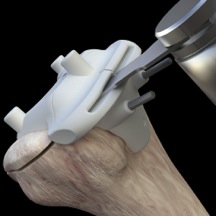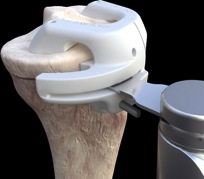Patient matched total knee replacement
The early results of this exciting new technology are very promising. Patient matched surgery allows accurate cuts and implant placement which should improve the end result of total knee replacement.
Knee replacement has been around since the 1970’s. Unfortunately the improvements in cutting guides (making them more accurate and easier to use) have not removed the need to place metal rods in the marrow part of the bones. In order to get the prosthesis sitting straight and oriented the right way, these rods are inserted into the your femoral canal (thigh bone marrow cavity) during surgery. This can result in fat traveling to the lungs, blood loss and occasionally allows the components to be inserted slightly rotated.
Computer assisted surgery
In the last five years or so new technologies have been used to improve the way the knee joint replacement is inserted during the surgery. Tools to measure how accurately we are able to insert the new knee joint have improved tremendously and this should result in better outcomes for you.
Computer assisted surgery was a major breakthrough because it allowed the surgeon to confirm that the new knee joint was straight during the operation (rather than waiting for an Xray after the operation to check this when it was too late). Unfortunately the computers did not help control the rotation of the new knee. The disadvantage of using computer assisted systems is that they require extra instrumentation, lengthen the surgical time and create extra potential complications (such as a broken bone where the guide pins are inserted). The hospitals also have to buy expensive computer systems and an extra person is required at each knee operation to run the computer.
The next generation of computer assisted surgery is called patient matched surgery. Computer analysis is now used in the planning stage of the knee surgery rather than during the operation itself. This is called “patient matched instrumentation” and no longer requires the previous expensive computer systems in the operating theatres or staff to run them. Slightly more effort is required from the surgeon before the operation but this is more than compensated for by having a quicker, easier and more accurate knee replacement operation.
What is patient matched instrumentation?
You will need to have a MRI scan and long leg standing Xray of your knee performed. There is no additional cost for these tests. These images are analysed by an engineer (with input from me) and a physical model of your bones is created. Measurements of the bone model are taken and the exact size of new knee to be implanted can be calculated before the surgery. Based on these models (and my clinical examination of your leg); a cutting block is generated which can only be used for you and no-one else. The cutting block guides me to cut off the exact amount of bone that will be replaced by the new knee.

During the surgery a standard (or slightly smaller) skin cut is undertaken to the knee. The block ‘locks into place’ on the femur in the exact position planned prior to the surgery. Since the block can only fit correctly in one position less exposure of the bone is required than was required for traditional surgery. This ensures that the alignment and rotation are correct with far less tissue trauma.

Benefits to the patient include:
- less time in surgery (shorter anaesthetic)
- reduced chance of a fat embolism
- reduced blood loss
- excellent alignment and rotation
- potentially a faster healing time
The early results of Patient Matched Total Knee Replacement Surgery are extremely promising. Those of us who have used the technique are convinced that it is a huge improvement over the previous surgical methods.